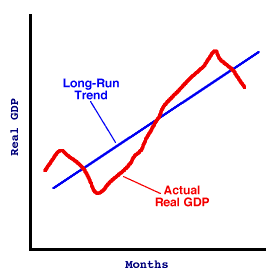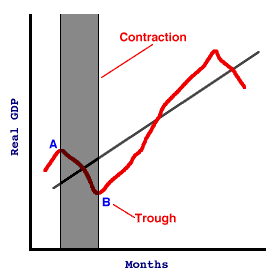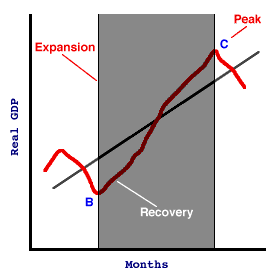
|
|
RISK PREMIUM: This has two very closely related uses. First, it's what risk averse people are willing to pay to avoid a risky situation. For example, if you would be equally happy with a guaranteed $900 or a 50-50 chance of getting either $500 or $1,500, then you're risk premium is $100. Second, it's the extra percentage points added to an interest rate to compensate for the risk of a loan. As a general rule, each 1 percent chance of default on a loan adds a risk premium of about 1 percent to the interest rate.
Visit the GLOSS*arama
|
|


|

|
                           BUSINESS CYCLE PHASES: The recurring, but irregular, pattern of business cycles can be divided into two basic phases--expansion and contraction. An expansion is a period of increasing economic activity and a contraction is a period of declining economic activity. These two phases are marked by two transitions. The transition from expansion to contraction is termed a peak and the transition from contraction to expansion is termed a trough. The early portion of an expansion is often referred to as a recovery. A business cycle is comprised of distinct phases, a general period of expansion followed by a general period of contraction. The transition from contraction to expansion is a trough and the transition from expansion to contraction is a peak. Business-cycle fluctuations gyrate around the long-run trend that tracks full-employment production capabilities.Long-Run Trend| Long-Run Trend |  |
Before getting to the specific phases, first consider the long-run trend of real GDP, or what is termed either potential real GDP or full-employment GDP. The long-run trend is illustrated by the blue line in the exhibit at the right. Potential real GDP is the amount of output that the economy can produce if all resources are fully employed. This line has a positive slope because the economy's production capabilities increase over time as the quantity and quality of resources increase. The positive slope of the long-run trend line reflects a 3 percent annual growth of production capabilities.However, as this exhibit reflects actual real GDP, indicated by the red line, does not coincide with this long-run trend of potential real GDP. During some periods actual real GDP is greater than potential real GDP and in other periods actual real GDP is less than potential real GDP. At some times actual real GDP grows faster than potential real GDP. In other times actual real GDP grows slower than potential real GDP. And on occasion actual real GDP declines even though potential real GDP continues to rise. The fact that actual real GDP does not coincide with the long-run trend of potential real GDP is the essence of business cycles and instability of the macroeconomy. Contraction| Contraction |  |
One of the two primary business-cycle phases is a contraction. A contraction, which is a period of declining economic activity, is illustrated in this exhibit.The shaded segment of the real GDP line between points A and B is the contraction. Clearly real GDP declines over this segment. A contraction generally takes the economy from at or above the long-run trend to below the long-run trend. Because the long-run trend represents full employment, unemployment results when real GDP is below the long-run trend, or when actual real GDP is less than potential real GDP. Moreover, the lower real GDP dips below the long-run trend, then the greater is unemployment. A contraction typically lasts about a year, but could be as short as six months or as long as eighteen months. The longest contraction on record, occurring during the Great Depression, lasted almost four years. TroughA contraction does not last forever, at least none have so far. The end of a contraction, and the onset of an expansion is a trough. The trough in the previous exhibit is indicated by point B. It is the end of the previous contraction that took the economy from point A to point B. While a trough, the lowest level of the business cycle, might not seem like a good thing, it really is. A trough means that the contraction has ended and that an expansion is about to begin. Expansion| Expansion |  |
The second of the two primary business-cycle phases is an expansion. An expansion, which is a period of increasing economic activity, is illustrated in this exhibit.The shaded segment of the real GDP line between points B and C is the expansion. Clearly real GDP increases over this segment. An expansion generally takes the economy from below the long-run trend to at or above the long-run trend. The early part of an expansion is usually termed a recovery because the economy is "recovering" from the contraction. Because the long-run trend represents full employment, when real GDP reaches the long-run trend and when actual real GDP is equal to potential real GDP, then the economy has full employment. Inflationary problems, however, arise when the actual real GDP exceeds potential real GDP as is the case in this diagram near point C. In addition, the more real GDP rises above the long-run trend, then the greater inflationary problems are likely to be. An expansion typically lasts about three to four years, but could be as short as one year or as long as a decade. The longest expansion on record, occurring during the 1990s, lasted ten years. PeakAn expansion, like a contraction, eventually comes to an end. The end of an expansion, and the onset of a contraction is a peak. The peak in the previous exhibit is indicated by point C. It is the end of the previous expansion that took the economy from point B to point C. While a peak, the highest level of the business cycle, might seem like a good thing, it really has a down side. A peak means that the expansion has ended and that a contraction is about to begin.

Recommended Citation:BUSINESS CYCLE PHASES, AmosWEB Encyclonomic WEB*pedia, http://www.AmosWEB.com, AmosWEB LLC, 2000-2024. [Accessed: May 5, 2024].
Check Out These Related Terms... | | | | | | | | | |
Or For A Little Background... | | | | | | |
And For Further Study... | | | | | | |
Related Websites (Will Open in New Window)... | |
Search Again?
Back to the WEB*pedia
|



|

|
ORANGE REBELOON
[What's This?]
Today, you are likely to spend a great deal of time calling an endless list of 800 numbers trying to buy either several magazines on computer software or a T-shirt commemorating the second moon landing. Be on the lookout for pencil sharpeners with an attitude.
Your Complete Scope
This isn't me! What am I?
|

|
|
In 1914, Ford paid workers who were age 22 or older $5 per day -- double the average wage offered by other car factories.
|

|
|
"Each of us is issued but one life, and we know full well how it all ends. It would be regrettable to squander this one chance on someone else's appearance, someone else's experience. " -- Joseph Brodsky, Writer
|

|
TVC
Total Variable Cost
|

|
|
Tell us what you think about AmosWEB. Like what you see? Have suggestions for improvements? Let us know. Click the User Feedback link.
User Feedback
|


|


